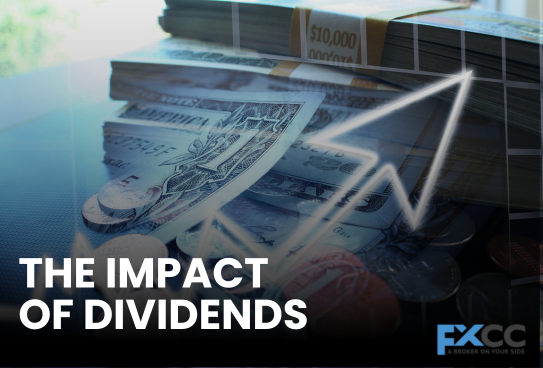Dividends are a key factor in the stock market, significantly influencing both stock prices and investor behavior. Understanding this dynamic can help investors better navigate market trends and refine their investment strategies.
Introduction
Dividends are frequently regarded as an indicator of a company’s financial well-being and stability. But how do these payments affect stock prices and investor behavior? Let’s explore this relationship to understand the influence of dividends on the stock market.
What are Dividends?
Corporate dividends are distributions of a company’s earnings to its shareholders, usually in the form of cash or additional shares of stock. These distributions usually come from a company’s profits and are provided regularly, often quarterly. Dividends offer investors a tangible return on their investment.

How Dividends Influence Stock Prices
Immediate Impact
When a company declares a dividend, it often leads to an immediate change in its stock price. On the ex-dividend date, when the stock starts trading without the value of its next dividend payment, the stock price typically drops by about the amount of the dividend. This adjustment reflects the cash outflow from the company to its shareholders.
Long-Term Influence
Over the long term, companies with a consistent history of paying dividends are often viewed as more stable and reliable investments. This perception can lead to higher stock prices as investors seek the security of regular income.
Investor Behavior and Dividends
Attraction of Income Investors
Dividends draw income-focused investors who prioritize steady income streams over capital gains. These investors, often retirees or those seeking predictable cash flows, are attracted to stocks with high and consistent dividend yields.
Signal of Financial Health
Dividends can indicate a company’s financial health. A company that regularly pays dividends is often seen as financially sound, encouraging more investors to buy its stock. Conversely, a reduction or elimination of dividends can signal financial trouble, potentially leading to a drop in stock price.
Behavioral Finance Perspective
From a behavioral finance standpoint, dividends can affect investor sentiment and decision-making. The regular receipt of dividends can create a positive reinforcement loop, encouraging investors to hold onto their stocks longer, thereby reducing market volatility.
The Role of Dividend Yield
Dividend yield, calculated as the annual dividends per share divided by the stock’s price per share, is a crucial metric for income investors. A higher dividend yield can make a stock more attractive, increasing demand and potentially driving up the stock price.
Dividend Announcements and Market Reaction
Positive Announcements
When a company announces an increase in its dividend, it often leads to a positive market reaction. Investors interpret this as a sign of confidence in the company’s future earnings, which can drive up the stock price.
Negative Announcements
Conversely, if a company announces a dividend cut, it can lead to a negative market reaction. Investors may view the cut as an indication of financial distress, resulting in a sell-off and a decrease in stock price.

Case Studies: Notable Dividend Impacts
Apple Inc. (AAPL)
Apple reinstated its dividend in 2012 after a long hiatus. The announcement was met with enthusiasm, leading to a boost in its stock price. Over the years, Apple’s consistent dividend payments have attracted a broad base of income investors.
General Electric (GE)
In contrast, General Electric’s decision to cut its dividend in 2017 was seen as a sign of underlying financial issues. The announcement led to a sharp decline in its stock price as investors reacted to the news.
The Long-Term Perspective on Dividends
Compounding Returns
Reinvesting dividends can lead to significant compounding returns over time. By using dividends to purchase additional shares, investors can increase their ownership in the company, leading to greater dividend payments in the future and exponential growth of their investment.
Stability in Turbulent Markets
During market downturns, dividend-paying stocks often provide a buffer against volatility. The steady income from dividends can help offset capital losses, making these stocks a safer choice for risk-averse investors.
Risks Associated with Dividend Investing
Dividend Cuts
While dividends are attractive, they are not guaranteed. Companies can cut or eliminate dividends during financial difficulties, which can lead to a decrease in stock price and loss of income for investors.
Overemphasis on Dividends
Focusing too heavily on dividends can lead investors to overlook other important factors, such as a company’s growth potential and overall financial health. It’s essential to balance dividend income with other investment considerations.
Conclusion Dividends play a crucial role in shaping stock prices and influencing investor behavior. They provide a steady income stream, signal financial health, and can attract income-focused investors. However, it’s important to consider the risks associated with dividend investing and to maintain a balanced approach. By understanding the impact of dividends, investors can make more informed decisions and enhance their investment strategies.


